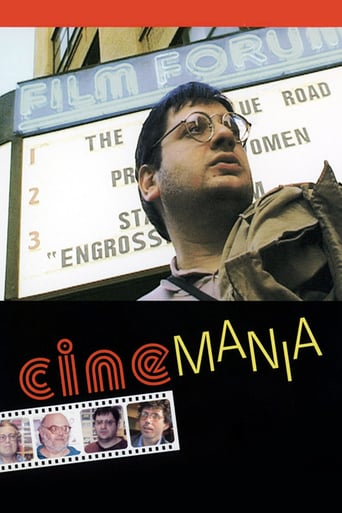LeRoyMarko
This documentary tells the story of five New Yorkers obsessed with movies. They live for films, doing nothing else. At some point in the documentary, I ask myself the question: do they have a depressing life or do they live in a dream world? Because, I think I would be able to live this kind of life. I'm a big fan of lists, of IMDB of course and of movie houses. Cinema truly offers an escape door to our daily life. At the same time, to find refuge in films, I would have to abandon a lot of things. Then, I'm not so sure I want to live this life! One fact is for sure, after seeing this documentary, you want to see more movies! And explore new fields. It's voyeurism at its best because the documentary doesn't give us too much information about the five movie buffs. It stays on the surface, using the five New Yorkers almost as freaks, deconnected from real life. There's a certain lack of details to the documentary.Out of 100, I gave it 76. That's good for **½ out of ****.Seen at home, in Toronto, on May 2nd, 2004.
jotix100
Manhattan is a mecca for the lonely. Nowhere in the world can people survive for years without the need of communicating with other people. Some of them have absolutely no life, or in the case of these five characters in this fantastic documentary, these are people who put all their energy into escaping from the real world. Their refuge is the many film theaters of Manhattan that show non commercial programs such as the ones that attract them. How much can they absorb? How much can they really enjoy the same films that attract them?. Watching this documentary one can't really say.
Of all five people analyzed in the film only Jack comes close to a normal person. He is a walking encyclopedia. He knows about cinema. I have seen him in numerous occasions and have talked to him. He is the source one wishes to have when one is thinking of an obscure passage of a forgotten film, domestic or foreign. His whole life revolves around the different showings around the city. His life is a mess, but at least, he gives the appearance of normalcy in comparison to the others.Roberta is an eccentric lady whose whole life revolves around collecting programs wherever she goes. She appears to go to films out of duty, not because she really enjoys what she is seeing. Her own anecdote of taking off her blouse during an air conditioned failure is a hoot. Talking to her after a film will give you no clue if she liked or disliked what she saw. She would be much better off staying home sorting out a whole lifetime at the movies and straightening the mess she lives in. I hate to see a fire in that tenement, or in some of the other apartments, for that matter.Co-directors Christlieb and Kijak know these people very well. They give us a bit of their world; they have captured the essence of these five lonely souls in the big city.
lor_
Cinemania, screened recently as a world premiere at AMMI in Queens (where it was partially shot), deals with the marginal world of true movie nuts: New Yorkers who attend anywhere from 500 to 1000 feature films in cinemas per year at the cost of leaving no time for virtually any other activities or "normal" social life.I am a "recovering cinemaniac" who attended 600 films per year throughout the '70s and '80s, but not now -I've moved on to other pursuits, mainly music. I personally know four of the five principals featured in this documentary. We used to meet on a nearly daily basis at MoMA, Film Forum, Walter Reade, the old Thalia, or many other now-defunct Gotham revival houses including the Gramercy, Regency, Theatre 80 St. Marks, Jean Renoir Cinema, Fifth Avenue Cinema, The New Yorker, Bleecker St. Cinema, Carnegie Hall Cinema, etc. Each of these true "characters" is quite serious about this avocation, collecting memorabilia (Roberta and Harvey), or making endless preparations and cross-referenced lists of upcoming showtimes so as not to miss anything important or rare that is screening (Jack). Eric has sadly succumbed to watching videos, but is still included here as sort of an "emeritus" cinemaniac.The filmmakers, who stated at the q&a post-screening that they were independently filming Jack when they joined forces on this single project, miss a great opportunity to really dig into the subject -the Golden Age of movie culture in New York, which existed back in the '50s, '60s and '70s. Pioneering figures like Anthology Archives' Jonas Mekas are still on the scene and could have been interviewed, and a study of the days of Amos Vogel, Sid Geffen, Richard Roud, Andy Warhol, et al would have made for a riveting documentary even if the "documents plus voices" approach of Ken Burns were all that could be conjured up of the past.Instead, the directors took the lazy contemporary approach, for which the audience rightly took them to task at the q&a. The five very interesting individuals are trailed around town during 2000/2001 in lame cinéma vérité style, revealing more silly foibles than insight. I felt very bad for my friends and acquaintances, who deserved a lot more than being treated as figures of fun. Ironically, what the 5 Cinemaniacs had to say at the Q&A (NOT recorded by these filmmakers) was vastly more interesting and revealing than anything shown in the film itself.The premise of this film is sadly off-target: the claim is made that cinemania flourishes in New York in this new 21st Century, when in fact anyone with any memory knows the Good Old Days are long gone. As Jack frequently points out, print quality is a serious problem. Absence of talented and dedicated projectionists is equally harmful. As imdb fans must know, everything today is driven by DVD, video and new technology. The great revival houses are gone. Sure there are dedicated restoration projects devoted to individual film titles, but the endless feast of revival films is no more, when the collected works of Bergman, Truffaut, Dreyer, Chabrol, Kurosawa, Antonioni and all the American masters were constantly on display right back through to the Silents. Heck, back in the '70s it was routine for COMMERCIAL FIRST-RUN CINEMAS to run Garbo, Keaton, Chaplin and Marx Bros. festivals. I was living in Cambridge back in the '60s when the Bogey and other revival cults really took hold.Nowhere in this flimsy documentary do we find about the Thousand Eyes film society, the history of midnight movies (begun at the old Elgin Theater, now the Joyce Dance Theater in Chelsea), Cinema 16 and the Underground Film movement (which presaged the Midnight Movies) or even a hint of the once rich ethnic cinemas (foreign language films shown without subtitles, Spanish, Indian, Polish, etc.) that were all killed off by video.
Alas, I hope someone delves into the fun by-gone eras of movie fanaticism -when GOING to catch a rare film was the impetus to self-education about the cinema. Even drive-ins were a great source in "them days", right up through the '70s. Today a movie nut is likely to be building a COLLECTION (undreamed of decades ago) of adulterated VHS or revisionist (how much added footage & commentary can be tossed into the pot) DVD material. As a purist, I never counted seeing a film on tv as actually SEEING it - it had to be on a screen (Marshall McLuhan had an explanation for this but I was merely intuitive). Today's movie buffs have settled for the illusion rather than the real deal (driven by our society's ever-reliance on planned obsolescence, as exemplified by the imminent end of the VHS just as BETA disappeared and DVD will be later destroyed (how about those self-destructing inferior quality laserdiscs??).Punchline is that this documentary was SHOT ON VIDEO (and then transferred to film), a fact commented upon derogatorily by Jack & others who revere 35mm (or 70mm). The current generation is treating film and video as interchangeable; a near-future generation will not even know what film is (was) once digital technology completely takes over in cinemas. All in the pursuit of (or worse, cutting corners to save) an almighty buck.


